July 12, 2016
While camping at Xakanaxa in the northeastern part of the Okavango Delta, my colleague, Ronald Mothobi, showed me how to make baobab yogurt.
Like many traditional foods, baobab yogurt is delicious, simple to make, takes a bit of time, and should be eaten as soon as it’s ready.
The ingredients are:
- Ripe baobab fruit
- Milk
- Honey or sugar (optional)
Baobab trees are fantastic ancient beings that can live for over four thousand (!) years in the sandy southern African landscape. The trees shed their leaves in winter, giving them the characteristic “upside down tree” appearance familiar to armchair safari goers and watchers of the “Lion King”.

Baobabs begin making fruit when they are about 200 years old. Yes – 200! So a fruiting baobab tree is an incredible investment of time. This is one reason it is illegal to cut down a baobab tree in Botswana. They are totally protected.
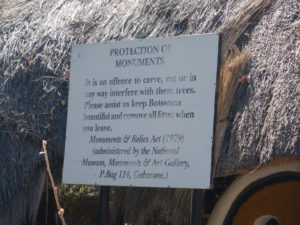
Like the trees, the fruits are remarkable in form and would give you a good bonk on the head if you happened to pass under one as it dropped.
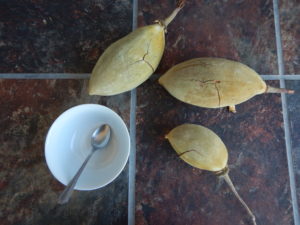
Baobab fruits are ready to eat when you find them on the ground. So they are easy to get and a large tree will produce hundreds of fruit. They are ripe when the inside is dry and chalky. If that doesn’t sound tasty, read on.
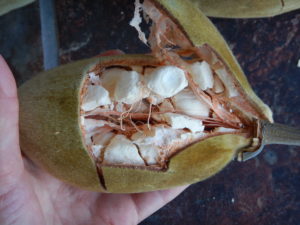
Breaking open baobab fruits is great fun, particularly for my two sons, who were delighted to whack and crack baobab fruits against rocks. The trick is to extract the cracked fruit from your child’s eager hands before he smashes it beyond all recognition.
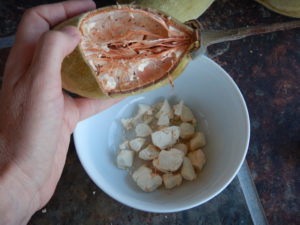
Once you crack open the fruit, scoop out the chunks of dry pulp powder. These encase heavy black seeds, so don’t bite down hard if you want your teeth to stay intact.

In a bowl, combine the chunks with enough milk that they are generously covered. You can also use water, but milk tastes more creamy. Wait for an hour or two and add more milk if the concoction gets too thick.
You can refrigerate or not – obviously in the bush, we just left the bowl on a table in the shade. In this case you may have to protect from monkeys.

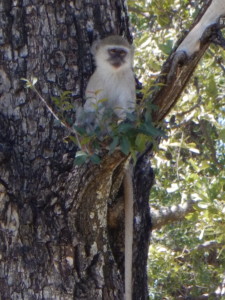
When most of the white baobab powder is hydrated with milk, the yogurt is ready to eat. Probably you should spit out the seeds – rather like eating watermelon.
I don’t sweeten baobab yogurt though (I suspect) my children would prefer it that way. You can also eat the dry baobab pulp straight out of the husk. It’s tangy and smooth. My 3 year-old nephew commented that is was “the most delicious thing he’d ever had”. Personally, I think mango is better, but I appreciated his enthusiasm.
Baobabs are considered “super fruits” due to all the goodies they contain – antioxidants etc. They are also used in the same way as cream of tartar, as a thickener for example.
On that note, I would warn against eating too much of the straight dry pulp. I did that once… I ate about ¾ of a large fruit and gave myself a most uncomfortable bout of gas and indigestion that made all sharing a tent with me regret the choice. The idea of “all things in moderation” apparently applies to raw baobab fruits. The yogurt however, was fine.

